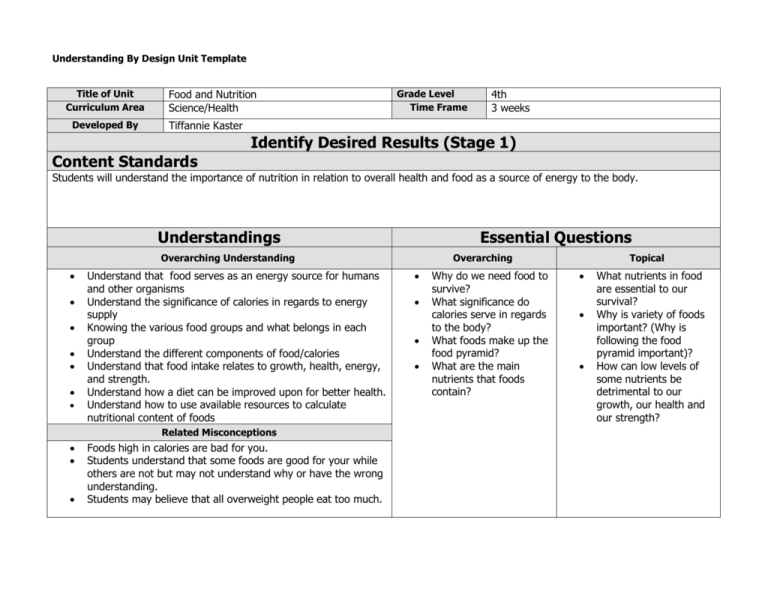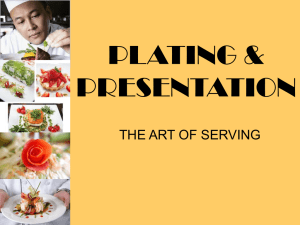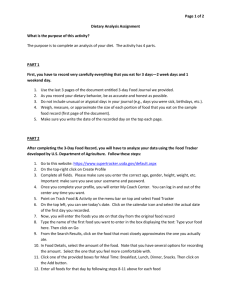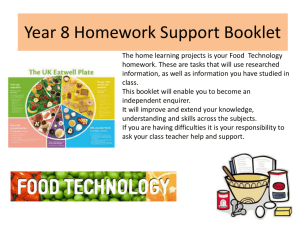ubd unit - mrassessment2011
advertisement

Understanding By Design Unit Template Title of Unit Curriculum Area Developed By Food and Nutrition Science/Health Grade Level Time Frame 4th 3 weeks Tiffannie Kaster Identify Desired Results (Stage 1) Content Standards Students will understand the importance of nutrition in relation to overall health and food as a source of energy to the body. Understandings Essential Questions Overarching Understanding Understand that food serves as an energy source for humans and other organisms Understand the significance of calories in regards to energy supply Knowing the various food groups and what belongs in each group Understand the different components of food/calories Understand that food intake relates to growth, health, energy, and strength. Understand how a diet can be improved upon for better health. Understand how to use available resources to calculate nutritional content of foods Related Misconceptions Foods high in calories are bad for you. Students understand that some foods are good for your while others are not but may not understand why or have the wrong understanding. Students may believe that all overweight people eat too much. Overarching Why do we need food to survive? What significance do calories serve in regards to the body? What foods make up the food pyramid? What are the main nutrients that foods contain? Topical What nutrients in food are essential to our survival? Why is variety of foods important? (Why is following the food pyramid important)? How can low levels of some nutrients be detrimental to our growth, our health and our strength? Knowledge Skills Students will know… Students will be able to… Key terms-carbohydrates, proteins, sugars, calories, nutrients, energy, fat, food groups, sugars, grains, dairy, my plate, The different levels of the food pyramid/plate and examples of foods that belong in each group. Identify the various food groups and nutrients that make up the foods in those groups Name and describe the main nutrients that foods contain Describe the different foods contained in the food pyramid Analyze a diet to determine if it contains a balance of foods Modify a diet to include a balance of foods. Assessment Evidence (Stage 2) Performance Task DescriptionGoal Role Audience Situation Product/Performance Standards All included below Stage 3 Other Evidence Learning Plan (Stage 3) Where are your students headed? Where have they been? How will you make sure the students know where they are going? How will you hook students at the beginning of the unit? What events will help students experience and explore the big idea and questions in the unit? How will you equip them with needed skills and knowledge? Students will be learning the importance of nutrition as it relates to their own energy needs as a living organism and the effects the different foods can have on a person along with the importance of a variety of foods. To ensure students know where they are headed each lesson includes an objective or the purpose for the activities so students know the reason behind the activities they are participating in. By having students bring in pictures of themselves, see lesson 1 below. Students will enjoy sharing their pictures with other students and will get them looking at how we grow and develop and the importance food and nutrition has played to get us there. As a final project students will have to analyze data they have collected from their own meals and reflect upon how it could be improved upon along with creating an improved meal log. To get to this point, students will have to be given all the tools needed to analyze their meals. By including a wide variety of lessons which teach all of the How will you cause students to reflect and rethink? How will you guide them in rehearsing, revising, and refining their work? How will you help students to exhibit and selfevaluate their growing skills, knowledge, and understanding throughout the unit? How will you tailor and otherwise personalize the learning plan to optimize the engagement and effectiveness of ALL students, without compromising the goals of the unit? How will you organize and sequence the learning activities to optimize the engagement and achievement of ALL students? different understandings that are expected of the students, I am ensuring that the students have the skills and knowledge they need to have no trouble with their final projects and in the end will achieve the overall goal of understanding the importance of nutrition in relation to overall healthy and energy means for living organisms. Students will have to reflect and rethink after many of the lessons when we have discussions in groups about work that we had done. This lessons include analyzing the schools menu and the food group exercises. The students will be guided through this process throughout the lessons while we are in groups discussing and as a class discussing and when it is time for the final project students will be using these reflecting skills to develop healthy meal logs. Students will throughout the unit be putting their new skills to use by developing their own food plate, analyzing the schools’ lunch menu, and analyzing their own meals. Each activity is followed by a discussion period so students can think through their skills and ask questions about things that they may be struggling with. The new USDA “My Plate”, that replaced the food pyramid in 2010, does a good job of stressing that everyone’s “plate” is different and encourages variety in the types of foods we each and is therefore a good reference to refer back to throughout the lesson. By referring back to the My Plate students create in this unit and students recording their own meal data the information becomes more personalized and tailored to each individual person. By encouraging students that everyone’s meals are different and that it is ok it makes all students feel comfortable about sharing the foods they eat and not ashamed. I tried to include an activity in the beginning of every day that either discussed material learned from the previous day/lesson or that engaged them into the new material. By letting students work in groups for a lot of the activities students at various levels of achievement are able to help each other learn the material. From: Wiggins, Grant and J. Mc Tighe. (1998). Understanding by Design, Association for Supervision and Curriculum Development ISBN # 0-87120-313-8 (ppk) Side Note: This unit is planned around a science period of about 30-45 minutes. When discussing food/calories and weight you have to very careful about wording and not discriminating against any children because of weight or diet issues. The teacher must be careful as not to make any student feel uncomfortable about themselves. This is meant as a means of health education and not meant to promote drastic eating changes or dieting. Parent involvement in this lesson is strongly encouraged. The new USDA “My Plate”, that replaced the food pyramid in 2010, does a good job of stressing that everyone’s “plate” is different and encourages variety in the types of foods we each and is therefore a good reference to refer back to throughout the lesson. Days 1 Lesson 1 Goal/Objective- Students understand that humans and other organisms need food to grow and that the amount of food can help and hurt our health and growth. Students will understand that food intake relates to growth, health, energy, and strength. Assessment- Observing children during classroom discussion and journal activity will assess that students understand the objectives. Materials- pictures brought in by students (3) baby, toddler, recent photo, photos of malnourished children, food plate worksheet. ExecutionStudents will bring in 3 pictures: one of themselves as a baby, one as small child and then picture of themselves now. We will hang them in the class to start a classroom discussion to learn what children know about how our bodies grow and why we food is important to our growth and health. Then students will be shown pictures of malnourished kids to lead into a discussion about how our bodies can show us that we are not getting enough food or the right types of foods and the importance of keeping our bodies healthy. Students will do a quick write in their journals about what they had learned that day about the importance of food to the overall growth and development of living organisms. Students should be informed about their final project right away so enough time is given to get the data students need. Students should be told that they should start writing down everything they eat every day for at least 5 days, one of them having to be on a weekend. Students will be given a meal log handout to keep track of their information on. Students should be told that within the next couple days students will be learning more about food groups and that they can leave out the information about calories until later in the unit and for now just record their meals. See below for final project details. Day 2-4 Lesson 2 Goal/Objective- Students will know the various food groups and what belongs in each group. Assessment- The individual food pyramid students develop on day 3, rubric attached. Observing discussion students have on day 2 and the journal responses students have on day 2 also. Materials- The book, D.W. the Picky Eater by Marc Brown , food plate examples from www.myplate.gov also included at the end of this unit, construction paper, colored pencils, markers, crayons and any other drawing materials, video http://www.youtube.com/watch?v=NjwuzOCuM24. Examples of foods from various food groups: can be actual food, pictures, plastic versions, etc... Day 21. As an introduction to this day D.W. the Picky Eater by Marc Brown will be read to the students it is a story about Arthur the Aardvark's sister, D.W., who is a picky eater. The family leaves her at home when they go out to eat until D.W. decides she might be missing something good by being so picky. This would serve as a connection to literacy and an introduction into how having a variety of food groups in your diet is important. 2. Students could then be introduced to the new USDA developed food plate. All the food groups will be introduced and examples of foods that belong in each will be given. Along with the new guidelines that the USDA has set with the new My Food Plate. The terms grains, fruits, vegetables, dairy and meats should all be included. Students should be informed that the food plate is a guideline for healthy eating and that each person’s plate may be a bit different but the important thing is having a variety of good foods on your plate. 3. Students complete a short journal entry about if they are picky eaters like D.W. and what foods they like and don’t like and if this story has made them think about trying new foods or not. Day 3-4 Students will watch a video to review information about the food groups. http://www.youtube.com/watch?v=NjwuzOCuM24 From here students could participate in a competitive activity. Examples of various foods will be at the front of the room, after designating different areas of the classroom as the food groups, divide the students in half and have a contest to see who can put the foods in the correct food groups the fastest. Rules: 1. Students will have to take turns, rotating through the desks or a line of students. 2. Students must walk the entire time or be given a 1 minute penalty for each occurrence. 3. Before trading off to the next team member students need to tag the next person. 4. Team members are encouraged to help out their teammates but may risk giving answers to the other team. 5. Results should not be given until the end to be fair to the first team to go. A quick discussion of the correct places to put the items would follow. Then students can develop a poster of their own Food Plate. Students can use construction paper and drawing materials to draw out their plate, label the different food groups and give a couple of examples of each group along with pictures to go along with each example. Students should include all of the food groups along with at least three examples for each group and pictures to go along with each group. Rubric is attached. In groups students will discuss the video and the food pyramids they developed. Students should discuss why they put foods in each category of their food pyramids, giving them an opportunity to discuss questionable foods with their peers and sharing ideas that others may have never heard of. Days 5 Lesson 3 Goal/Objectives- 1. Students will understand the significance of calories in regards to energy supply. 2. Students will understand the different components of food: carbohydrates, proteins and fats. Assessment- Worksheet students do on carbohydrates, proteins and fats. Materials- video- http://www.youtube.com/watch?v=uvahFySXhLs, carbohydrate, protein, fats worksheet ExecutionDay 5Students will watch a video (about 3 mins) - http://www.youtube.com/watch?v=uvahFySXhLs , which includes information about carbohydrates, fats, and proteins and the significance of calories intake in regards to how much activity students do and the importance of balancing those calories. After the video the contents will be discussed further and students will do a worksheet on the differences between carbohydrates, proteins and fats. Days 6-8 Lesson 4 Goals/Objectives- Understand how to use available resources to calculate nutritional content of foods. Materials- school lunch menu, Calorie resources such as books, handouts, and websites such as www.calorielab.com, calorie calculating apps on the iPad or other electronic devices or computer software programs such as Nutrition Calc Plus. Assessment- Day 6- Research information the students have found about 5 food items of their choosing will assess if students are able to utilize the new research tools. Days 7-8: Students will analyze a person’s diet, for the amount of calories per meal, what food group each food is in and if each food is a carbohydrate, protein, or fat. Day 6The worksheet from the previous day can be discussed. Students will then be shown a couple different resources that show types of foods and their calories such as books, handouts, websites such as www.calorielab.com, calorie calculating apps on the iPad or other electronic devices or computer software programs such as Nutrition Calc Plus. By utilizing books and not just technology resources students are integrating their literacy skills into the lesson. In groups students will come up with 5 foods that they would like to research and learn more about their nutritional value. By doing this, students will get comfortable working with these resources which they will use during their final project and other work. Depending on the number of resources available students can rotate through using electronic guides, and using paper resources. Students will write down their findings to be shared with the teacher and the class. Day 7-8 Students will be given the school lunch menu to look at. To get students comfortable analyzing someone’s diet, students in small groups will use the same resources they practiced using the day before to determine the calories, the food groups and type of calorie source (carbohydrate, protein, fat) of all the foods for 3 days on the lunch menu. This will give students more practice on utilizing the available resources to determine nutritional content of foods before they begin work on their final project. Day 9-10 Lesson 5 Goals/objective- Students will understand how a diet can be improved upon for better health and why a variety of food is important. Assessment- Students suggestions made about the school’s menu Materials- students’ menu observations, ExecutionDay 9- As a class a discussion can be done about what food groups are missing, which foods are high in calories and if there is variety in the types of foods. Students then can be guided through an example of how to improve the menu. Students will share their input about modifications and why they think it is important along with teacher feedback. After guiding students through an example or two of types of modifications that can be done to improve the menu students will go back to their groups and determine 4 ways that the 3 days they analyzed on the school’s lunch menu could be improved upon, supporting their suggestion with a couple sentences on why they made the suggestion. Day 10Students will share and discuss their suggestions for the schools menu. This time can also be utilized to review any of the topics that students appear to be struggling with. Students can also play educational games on http://school.fueluptoplay60.com/tools/nutritioneducation/games/littled/quintricious.php Day 11-13 Final Project Goals/objectives Students will.. Understand the significance of calories in regards to energy supply Knowing the various food groups and what belongs in each group Understand the different components of food/calories Understand how a diet can be improved upon for better health. Understand how to use available resources to calculate nutritional content of foods Assessment- The student’s final project will assess majority of the essential understandings expected of the students. Students will analyze their own meal logs by calculating calories, grouping foods into correct food groups and determining the source of their calories. Students will then have to suggest modifications to make their meals healthier according to the USDA suggestions. Materials- original meal log done by students, calorie/food resources (same used for previous lessons) new meal log sheets. ExecutionAt the beginning of the lesson students were asked to keep track of their meals for 5 days with one of those days be a weekend. Students should have had plenty of time to complete this task and should bring their meal logs to class for this day. Students will then have to take their meal log and using all the information they learned throughout the unit write a paper including: 1. how many calories total they are consuming each day, and each week 2. what food groups they are getting a lot of, if any, which ones are low or missing in their diet 3. what is the main source of their calories: carbohydrates, sugars, or fats 4. What could you do to improve your diet and its nutritional value? 5. with what they have learned because of this unit (about themselves, about food, facts they liked, parts they enjoyed or didn’t enjoy because) Also students should include a modified version of their food log which would make it healthier, meaning including a variety of foods, variety of food groups, and lower calories and higher nutritional value foods. For this project students are allowed to use resources they have used previously in and will have time in class to work on it. With it being the final project students are expected to have accurate and complete information with no spelling errors. See attached rubric. Rubric for Food Plate Poster Teacher Name: Tiffannie Kaster Student Name: CATEGORY 4 ________________________________________ 3 2 1 Food group labels All of the food groups are included on the poster. All but one of the The poster is food groups are missing 2 of food included on the groups. poster The poster is missing more than 2 food groups. Examples Three or more examples are given for every food group. Three or more examples are given for almost all of the food groups. At least two examples are given for all of the food groups. Less than two examples are given for each food group. Pictures Pictures are Pictures are included for all included for most the food groups. of the food groups. Pictures are not included for most of the food groups Pictures are not included for any of the food groups. Final Project: Paper Rubric Teacher Name: Tiffannie Kaster Student Name: CATEGORY 4 ________________________________________ 3 2 1 Organization Information is very organized with wellconstructed paragraphs. Information is organized with well-constructed paragraphs. Information is organized, but paragraphs are not wellconstructed. The information appears to be disorganized. Amount of Information All topics are addressed and all questions answered with at least 2 sentences about each. All topics are addressed and most questions answered with at least 2 sentences about each. All topics are One or more addressed, and topics were not most questions addressed. answered with 1 sentence about each. Mechanics No grammatical, spelling or punctuation errors. Almost no grammatical, spelling or punctuation errors A few grammatical spelling or punctuation errors. Many grammatical, spelling, or punctuation errors. Final project: Modified Meal Log Rubric Student Name: ________________________________________ CATEGORY 4 3 2 1 Modifications made At least two modifications were made to the meal log for all 5 days. At least two modifications are included on most days. No less than 1 modification was made on most days. Less than 1 modification was made on each day in the meal log. Accuracy of Modifications Modifications are accurate and reflect a healthy diet. Most modifications are accurate and reflect a healthy diet. Some modifications are accurate and reflect a healthy diet. None of the modifications are accurate or reflect a healthy diet. Original Meal Log Original Meal log is attached and is complete. Including all meals for 5 days including 1 weekend. Original Meal Log is attached and is mostly complete including most meals for the 5 days including 1 weekend. Original Meal log is attached and is missing 12 days of meals or student didn't include a weekend day. Original Meal log is missing or includes less than 3 days of meals.






